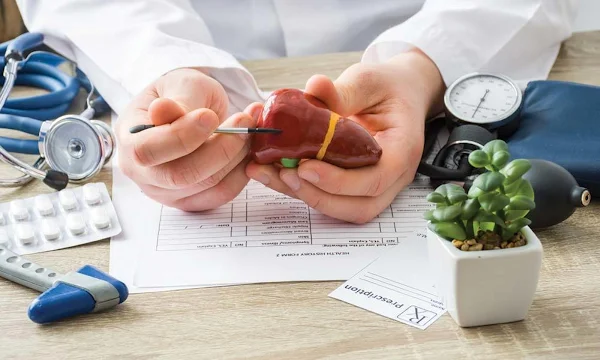Gallbladder And It Associated Problems - Dr Appiah
GALLBLADDER is a small pouch that sits just under the liver. The gallbladder stores bile produced by the liver. After meals, the gallbladder may be full of bile and about the size of a small pear.
The
gallbladder is the pear-shaped organ located at the right upper abdomen just
under the ribcage.
GALLBLADDER FUCTION
Its
primary function is to store and concentrate bile, a yellow-brown digestive
enzyme produced by the liver. The gallbladder is part of the biliary tract.
Bile: is a liquid that helps you
digest fatty foods. The gallbladder releases it into your small intestine. And
your gallbladder is an organ you can live without.
READ ALSO: How Apples Help Keep The Gallbladder in good Condition
GALLBLADDER
INFECTION
Nausea
or vomiting: Nausea and vomiting are common symptoms of all types of
gallbladder problems. But only chronic gallbladder diseases may cause digestive
problems, such as acid reflux, gas, nausea, and vomiting.
Fever
or chill. An unexplained fever may signal that you have infection.
SIGNS AND SYMPTOMS OF CHOLECYSTITIS
Severe
pain in your upper right or center abdomen
Pain
that spreads to your right shoulder or back.
Tenderness
over your abdomen when its touched
Nausea
Vomiting
Fever
CAUSES OF GALLBLADDER INFECTION
Inflamed
gallbladder (Cholecystitis) inflammation of the gallbladder can be caused by
gallstones
Excessive
alcohol use. Or even tumors that cause bile build up.
But
the most common cause ofcholesysttitis is gallstones.
GALLSTONES
(Cholelithiasis)
A hardened deposit within the
fluid in the gallbladder, a small organ under the liver
Gallbladder
with stone
Chronic: can last for years or be lifelong.
READ ALSO: Liver Health: Naturally Taking Care Of Your Body
What happens when you have your gallbladder removed?
If
you have your gallbladder removed, watch your diet carefully
afterwards……..after surgery
Your
liver still makes enough bile. But you might have difficult processing fatty
foods-at least for a while.
More
than half of patients who have their gallbladder removed have trouble digesting
fat
BILE OR GALL
Is
a dark green to yellowish brown fluid, produced by the liver of most
vertebrates that aids in the digestion of lipids in the small intestine. In
humans, bile is produced continuously by the liver (liver bile) and stored and
concentrated in the gallbladder.
If
you vomit bile more than once, a medical condition might be causing the
problem. One common cause is the bile reflux, which happens when bile backs up
from the liver into your stomach and esophagus.
Bile
reflux is not the same as acid reflux. You get your acid reflux when acid backs
up from stomach into your esophagus.
OTHER DISEASES THAT
AFFECT THE GALLBLADDER
Biliary Dyskinesia
This
is a motility syndrome that results from an abnormally functioning sphincter of
Oddi. Your sphincter of Oddi is a muscular valve that controls the flow of
digestive juices and bile from the liver and pancreas to the small intestine.
If the sphincter of Oddi is not working properly, there is a backup of fluid in
the ducts, causing an intensely painful obstruction
FUNCTIONAL
GALLBLADDER DISORDER
This
condition causes biliary pain in the absence of gallstones or a sphincter of
Oddi problem. A test called a Cholecystokinin (CCK) – stimulating Cholescintigraphyis
needed to confirm the diagnosis.
Primary Sclerosis
Cholangitis
Primary
Sclerosis Cholangitis (PSC) is chronic inflammation disease of the gallbladder
and liver that may cause debilitating itching from bile acid accumulation. As
the bile accumulates in the liver, cirrhosis develops, and eventually the liver
loses its ability to function. Many people with PSC ultimately need a liver
transplant.
MEDICAL
HISTORY
During
a medical history, your doctor will evaluate your personal and family history
of gallbladder disease. He will also ask you questions about your symptoms,
like whether you are experiencing upper right sided abdominal pain and if so,
whether it is with eating a fatty meal.
PHYSICAL
EXAMINATION
In
addition to a medical history, your doctor will check your vitals and perform a
physical examination to look for sign of gallbladder disease like fever or
jaundice, among others. Lastly, your doctor will likely perform a maneuver called “Murphy’s sign” which
entails the doctor pressing on your gallbladder to see if any pain is elicited.
HOME REMEDIES FOR GALLBLADDER DISORDERS
1.
Momordica
charantia
2.
Stachytarpheta indica
3.
Acalypha wikensiana
4.
Zea
maize











.jpg)

